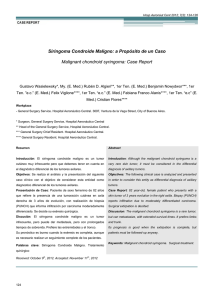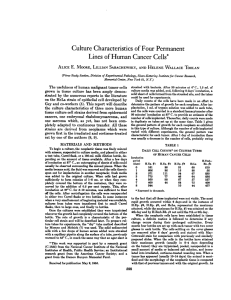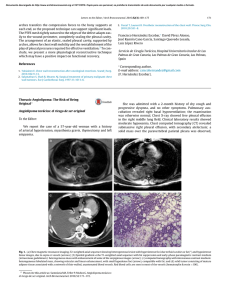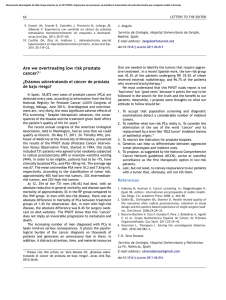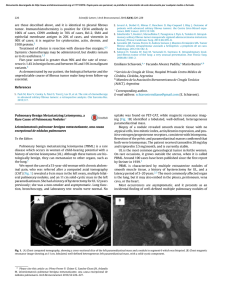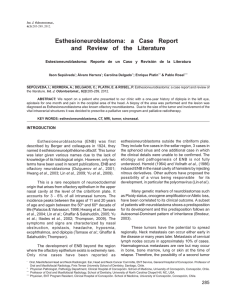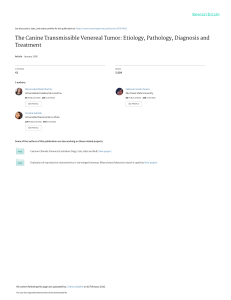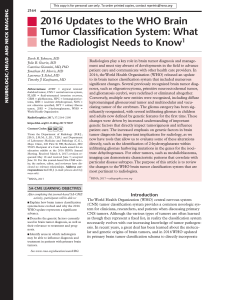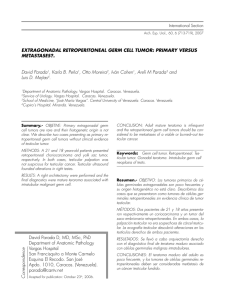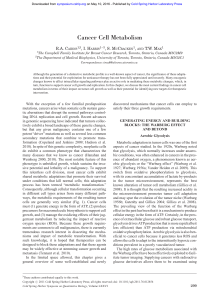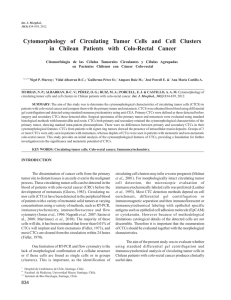Granular cell tumor: report of 8 intraoral cases
Anuncio
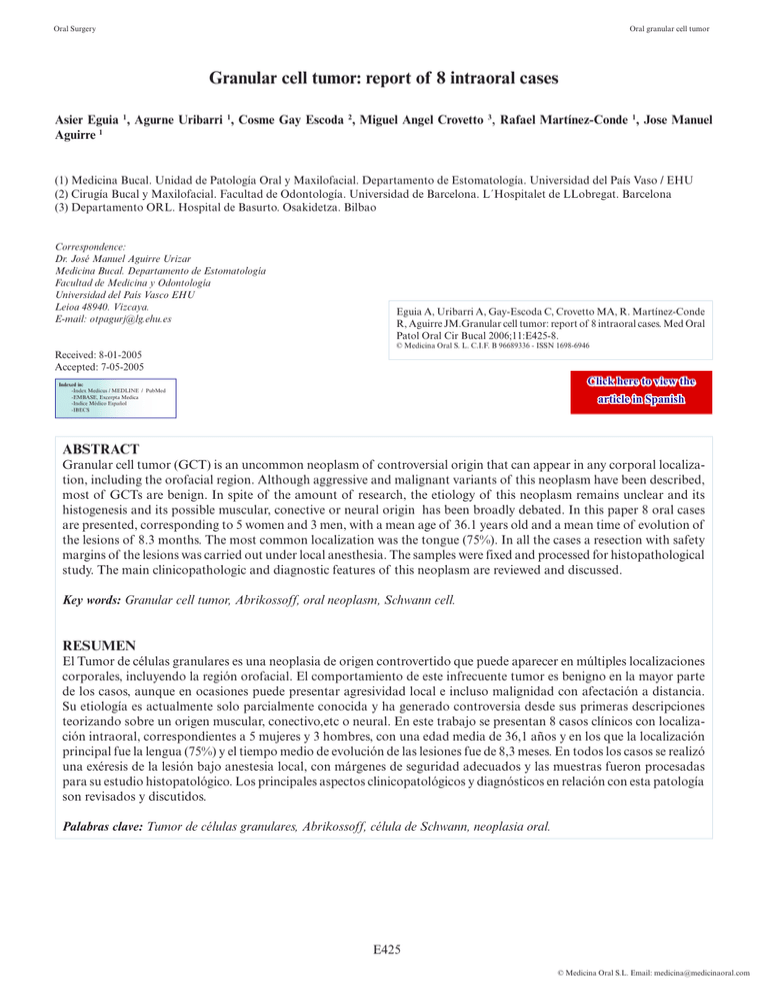
Oral Surgery Oral granular cell tumor � Granular cell tumor: report of 8 intraoral cases Asier Eguia 1, Agurne Uribarri 1, Cosme Gay Escoda 2, Miguel Angel Crovetto Aguirre 1 , Rafael Martínez-Conde 1, Jose Manuel 3 (1) Medicina Bucal. Unidad de Patología Oral y Maxilofacial. Departamento de Estomatología. Universidad del País Vaso / EHU (2) Cirugía Bucal y Maxilofacial. Facultad de Odontología. Universidad de Barcelona. L´Hospitalet de LLobregat. Barcelona (3) Departamento ORL. Hospital de Basurto. Osakidetza. Bilbao Correspondence: Dr. José Manuel Aguirre Urizar Medicina Bucal. Departamento de Estomatología Facultad de Medicina y Odontología Universidad del País Vasco EHU Leioa 48940. Vizcaya. E-mail: [email protected] Received: 8-01-2005 Accepted: 7-05-2005 Eguia A, Uribarri A, Gay-Escoda C, Crovetto MA, R. Martínez-Conde R, Aguirre JM.Granular cell tumor: report of 8 intraoral cases. Med Oral Patol Oral Cir Bucal 2006;11:E425-8. © Medicina Oral S. L. C.I.F. B 96689336 - ISSN 1698-6946 Click here to view the Indexed in: -Index Medicus / MEDLINE / PubMed -EMBASE, Excerpta Medica -Indice Médico Español -IBECS article in Spanish ABSTRACT Granular cell tumor (GCT) is an uncommon neoplasm of controversial origin that can appear in any corporal localization, including the orofacial region. Although aggressive and malignant variants of this neoplasm have been described, most of GCTs are benign. In spite of the amount of research, the etiology of this neoplasm remains unclear and its histogenesis and its possible muscular, conective or neural origin has been broadly debated. In this paper 8 oral cases are presented, corresponding to 5 women and 3 men, with a mean age of 36.1 years old and a mean time of evolution of the lesions of 8.3 months. The most common localization was the tongue (75%). In all the cases a resection with safety margins of the lesions was carried out under local anesthesia. The samples were fixed and processed for histopathological study. The main clinicopathologic and diagnostic features of this neoplasm are reviewed and discussed. Key words: Granular cell tumor, Abrikossoff, oral neoplasm, Schwann cell. RESUMEN El Tumor de células granulares es una neoplasia de origen controvertido que puede aparecer en múltiples localizaciones corporales, incluyendo la región orofacial. El comportamiento de este infrecuente tumor es benigno en la mayor parte de los casos, aunque en ocasiones puede presentar agresividad local e incluso malignidad con afectación a distancia. Su etiología es actualmente solo parcialmente conocida y ha generado controversia desde sus primeras descripciones teorizando sobre un origen muscular, conectivo,etc o neural. En este trabajo se presentan 8 casos clínicos con localización intraoral, correspondientes a 5 mujeres y 3 hombres, con una edad media de 36,1 años y en los que la localización principal fue la lengua (75%) y el tiempo medio de evolución de las lesiones fue de 8,3 meses. En todos los casos se realizó una exéresis de la lesión bajo anestesia local, con márgenes de seguridad adecuados y las muestras fueron procesadas para su estudio histopatológico. Los principales aspectos clinicopatológicos y diagnósticos en relación con esta patología son revisados y discutidos. Palabras clave: Tumor de células granulares, Abrikossoff, célula de Schwann, neoplasia oral. E425 © Medicina Oral S.L. Email: [email protected] Med Oral Patol Oral Cir Bucal 2006;11:E425-8. Oral granular cell tumor � INTRODUCTION The granular cell tumor (GCT) is an uncommon neoplasm that was described for the first time by Abrikossoff in 1926 (1-3). As the knowledge about the etiology of this tumor increased it has received different names. Thus, the GCT has also been termed, tumor of Abrikossoff, myoblastoma, granular cell neurofibroma or granular cell schwannoma. This fact shows the controversy that the GCT has caused along the time, for its peculiar behavior, variable localization and its not yet still completely clarified etiology (1-3). The GCT can develope at any age (4-6) and while some authors (4) have observed a greater prevalence among women, others (3) have not been able to verify gender differences. This tumor can appear in different parts of the body, nevertheless more than half of the cases are presented in the head and neck area. The most frequent orofacial localization is the tongue (7-10). Usually, there is only one lesion, although cases of multiple lesions have been reported (11). In most of cases the GCT has a benign behavior. Occasionally, it is locally aggressive and 2% of cases are manifestly malignant with distant involvement (12,13). In this research we present 8 cases of GCT of intraoral localization and we review the main aspects of this neoplasm. Patients Our study group comprised eight patients referred to our Dental Clinic of the University Of The Basque Country / EHU and to the University of Barcelona, 5 women (62.5%) and 3 men (37.5%), with a mean age of 36.1 years (range 1760). Table I shows the main clinic data from the patients. In all cases the lesions were initially single and manifested as non-ulcerated painless tumors, of slow growth and long evolution. The mean time of clinical evolution was of 8.3 months (range 3-24). Six cases (75%) were located in the tongue, one in the lower gingiva and another in the yugal mucosa. All the cases were observed during the exploration as a firm submucosa nodular tumor, of rosy color and with clear delimitation. All the lingual lesions, were located in the lateral zones of the lingual dorsum and characteristically showed loss of the gustatory papillae and leveling of the overlying mucosa, a reason why some cases were initially suspicious of malignancy until the histopathological study was performed (Figures 1 and 2). Fig. 1. A 30-years old man with a lingual granular cell tumor of more than three months of evolution (case 6). Fig. 2. A 60-years old woman with a lower gingival granular cell tumor of more than six months of evolution (case 1). Table 1. Summary of patients data. Case Age Sex Localization Evolution time (months) 1 60 F Lower gingiva 6 2 17 F Tongue 10 3 40 F Buccal mucosa 5 4 32 F Tongue 24 5 41 F Tongue 7 6 30 M Tongue 3 7 44 M Tongue 8 8 25 M Tongue 4 Fig. 3. Typical hystopathological aspect of the granular cell tumor, characterized by the presence of cells with granular cytoplasm and round nuclei (H&E 40x). E426 © Medicina Oral S.L. Email: [email protected] Oral Surgery Oral granular cell tumor � Fig. 4. Severe pseudoepitheliomatous hyperplasia in a granular cell tumor case (H&E 20x). In all cases an extirpation-biopsy with safety margins of the lesion under local anesthesia was carried out. Later, all the samples were processed for histopathological study. In some of the samples immunohistochemistry techniques were also performed. The tumors were constituted by a poorly circumscribed proliferation of polygonal cells with a central small nucleus and a pronunced eosinophilic and granular cytoplasm. Mitoses were not apparent seen. In seven cases (87.5%), a characteristic pseudopitheliomatous hyperplasia was seen in the overlying escamous epithelium (Figures 3 and 4). DISCUSSION The granular cell tumor (GCT) is an uncommon bening neoplasm that still reveals some controversial aspects. In our case series the GCT was more prevalent among the women comprised into the 4th and 5th decade of the life and the most common localization was the tongue (1-6). This data are in agreement with those from other authors which points a predilection for the middle aged people and the tonge as main localization. The existence of a gender predilection is not unanimously accepted. Although some authors have speculated on a hypothetical mediation of the sexual hormones in the etiology of the GCT, it has not been clearly demonstrated up to now (1-5). In most of our cases, the mean time of evolution was high. This is demonstrative of the slow growth of this neoplasm considered to be roughly 0.5-1 mm a year (1-5). Clinically, the appearence of GCT is indistinguishable from that of other bening connective neoplasms as fibromas, lipomas, etc. or neural as neoplasms as schwannomas, neurofibromas or neuromas. The modification of the overlying mucosa in the lingual lesions, is a specially important fact that can make the clinical appearence of the lesion look like a carcinoma. This phenomenon is not frequent in other types of bening tumors previously mentioned and was present in all cases that showed a marked pseudoepitheliomatous hyperplasia. The realization of a correct incisional or excisional biopsy with safety margins if possible together with a histopathological study is absolutely neccesary for a proper diagnosis and treatment of the lesion (1-5). The GCT has a benign behavior in most of cases. Recurrences are uncommon and frequently are the result of an incomplete resection of the original lesion (12). Nevertheless, locally agresive and manifestly malignant variants of this tumor have been described in the literature (12-14). In our case series no recurrences after the exeresis have been observed up to now. The malignant variant of GCT is really quite uncommon and reveals clinical evidence of an aggressive nature and differential histologic characteristics as necrosis, polymorfic tumoral cells, vesicular nuclei with large nucleoli, abundant mitoses, etc. Its great proliferative activity can be demostrated through immunochemistry by the positive testing for Ki67 and p53 (16). In most of our cases (87.5%), we observed pseudoepithliomatous hyperplasia in the overlying epithelium of the tumor. In other studies (1-5) the number of cases was not so high and did not exceed 50%. We think that this high prevalence in our cases could be related with other clinical parameters as the long time of evolution of the lesions or the more frequent lingual localization. Although it has not been demonstrated that the presence of pseudoepitheliomatous hyperplasia has pronostical implications, we believe it should be take into consideration, otherwise in presence of determined circumstances there may be an erroneus diagnosis of oral carcinoma that could advocate an aggressive therapy. For these reasons, it is really important to carry out the biopsy correctly, extracting the sample in its enterity to include all the elements that are necessary for the histological study. The differential diagnosis of GCT must be done with other bening connective and neural tumors, as fibromas, lipomas, neuromas, neurofibromas or schwannomas, with its malingnant variants and even with the oral carcinoma. Immunochemistry besides helping to stablish the correct diagnosis has allowed to improve the knowledge of the controverted origin of this tumor [14-18]. Initially, it was thought that striated muscular cells were the progenitors of this tumor. Later on, new hypotheses based on immunochemistry studies were developed implicating mesenchymal cells, neural crest cells, histiocytes or Scwann cells in the histogenesis of GCT. At present, most of the authors consider that Schwann cells are the precursors of this tumor because of the the positive testing for S-100 protein and antigens among others as vimentina, glycoprotein or leu-7 and the observations using electronic microscopy which show a continuous basal layer around the tumoral cells with certain resemblance to the perineurium and the presence E427 © Medicina Oral S.L. Email: [email protected] Med Oral Patol Oral Cir Bucal 2006;11:E425-8. � of structures compatible with myelin inside the liposomes [14,18]. However, many aspects are still unclear as to why and how this tumoral differentiation takes place. In spite of the controverted origin of this tumor, when the extirpation is carried out correctly with enough safety margins the prognosis is positive, due to its slow growth, uncommon aggressiveness and its low tendency to recurrence [1-3,12-14]. REFERENCES 1. Ordoñez NG, Mackay B. Granular cell tumor: a review of the pathology and histogenesis. Ultrastructur Pathol 1999;23:207-22. 2. Ordoñez NG. Granular cell tumor: a review and update. Adv Anat Pathol 1999;6:186-203. 3. Billeret-Lebranchu V. Granular cell tumor: Epidemiology of 263 cases. Arch Anat Cytol Pathol 1999;47:26-30. 4. Nishida M, Inoue M, Yanai A, Matsumoto T, Malignant granular cell tumor in maseter muscle: case report. J Oral Maxillofac Surg 2000;58:345-8. 5. Said al Naief N, Brandwein M, Laeson W, Gordon R, Lumerman H. Synchronous lingual granular cell tumor and squamous carcinoma. A case report and review of the literature. Arch Otolaryngol Head Neck Surg 1997;123: 543-7. 6. Billeret-Lebranchu V, Martin de la Salle E, Vandenhaute B, LecomteHoucke M. Granular cell tumor and congenital epulis. Histochemichal and immunohistochemical study of 58 cases. Arcg Anat Cytol Pathol 1999;47:31-7. 7. Gardner ES, Goldberg LH. Granular cell tumor treated with Mohs micrographic surgery: report of a case and review of the literature. Dermatol Surg 2001;27:772-4. 8. Martin RW, Neldner KH, Boyd AS, Coates PW. Multiple cutaneous granullar cell tumors and neurofibromatosis in childhood. Arch Dermatol 1990;126:1051-6. 9. Carinci F, Marzola A, Hassanipour A. Granular cell tumor of the parotid gland. A case report. Int J Oral Maxillofac Surg 1999;28:383-4. 10. Milián A, Bagan JV, Cardona F, Lloria E, Martorell M. Tumor de células granulares: presentación de un caso clínico de localización inusual. Med Oral 1997;2:248-53. 11. Collins BM, Jones AC. Multiple granular cell tumor of the oral cavity: report of a case and review of the literatura. J Oral Maxillofac Surg 1995;53:707-11. 12. Giuliani M, Lajolo C, Pagnoni M, Boari A, Zannonni GF. Granular cell tumor of the tongue (Abrikossoff´s tumor). A case report and review of the literature. Minerva Stomatol 2004;53:465-9. 13. Budiño-Carbonero S, Navarro-Vergara P, Rodriguez-Ruiz JA, Modelo-Sanchez A, Torres-Garzón L, Rendón-Infante JI et al. Tumor de células granulosas: revisión de los parámetros que determinan su posible malignidad. Med Oral 2003;8:294-8. 14. Jardines L, Cheung L, Livolsi V, Hendrickson S, Brooks JJ. Malignant granular cell tumor; report of a case and review of the literature. Surgery 1994:116:49-54. 15. Maiorano E, Faviua G, Napoli A, Resta L, Ricco R, Viales G et al. Celular heterogeneity of granular cell tumors: a clue to their nature?. J Oral Pathol Med 2000; 29: 284-90. 16. Williams HK, Williams DM. Oral granular cell tumours: a histological and immunocytochemical study. J Oral Pathol Med 1997;26:164-9. 17. Dámores ES, Ninfo V. Tumors of the soft tissues composed of large eosinophilic cells. Sem Diagn Pathol 1999; 16:178-89. 18. Liu K, Madden JF, Olatidoye BA, Dodd LG. Features of bening granular cell tumor on fine needle aspiration. Acta Cytol 1999;43:552-7. E428 © Medicina Oral S.L. Email: [email protected] Oral granular cell tumor
